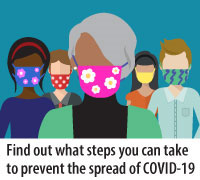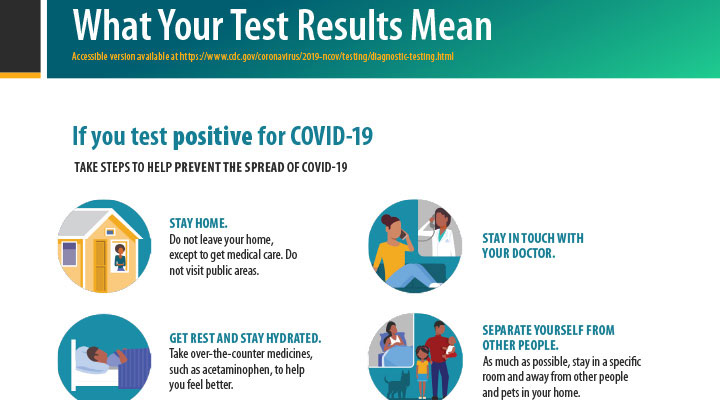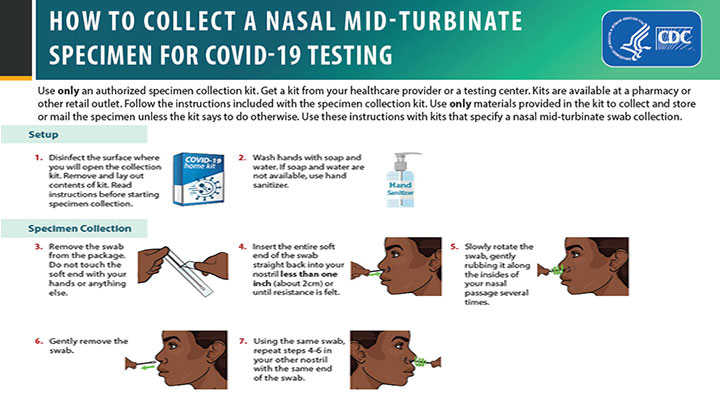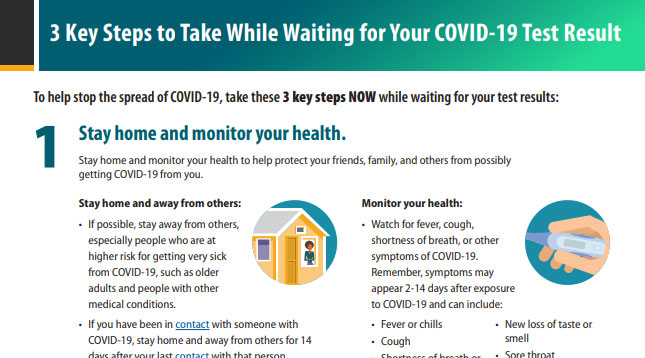Many of our patients have questions about Covid testing. It can be a little confusing at times. So here is a brief primer from the CDC on when, how, why, and who to test, as well as how to interpret the results of testing. Hold down the Ctrl button on your computer and click on the blue hyperlinks to be taken to more detailed information.
To maximize protection from the Delta variant and prevent possibly spreading it to others, get vaccinated as soon as you can and wear a mask indoors in public if you are in an area of substantial or high transmission.
COVID-19 Testing Overview
Find out who should get tested. Protect yourself and others. Wear a mask, stay at least 6 feet from others, avoid crowds and poorly ventilated indoor spaces, and wash your hands often.
Types of tests
COVID-19 tests are available that can test for current infection or past infection.- A viral test tells you if you have a current infection. Two types of viral tests can be used: nucleic acid amplification tests (NAATs) and antigen tests.
- An antibody test (also known as a serology test) might tell you if you had a past infection. Antibody tests should not be used to diagnose a current infection.
Who should get tested for current infection
- People who have symptoms of COVID-19.
- Most people who have had close contact (within 6 feet for a total of 15 minutes or more over a 24-hour period) with someone with confirmed COVID-19.
- Fully vaccinated people should be tested 3-5 days following a known exposure to someone with suspected or confirmed COVID-19 and wear a mask in public indoor settings for 14 days or until they receive a negative test result.
- People who have tested positive for COVID-19 within the past 3 months and recovered do not need to get tested following an exposure as long as they do not develop new symptoms.
- • Unvaccinated people who have taken part in activities that put them at higher risk for COVID-19 because they cannot physically distance as needed to avoid exposure, such as travel, attending large social or mass gatherings, or being in crowded or poorly-ventilated indoor settings.
- People who have been asked or referred to get tested by their healthcare provider, or state, tribal, localexternal icon, or territorial health department.
When you are fully vaccinated and traveling internationally
International travelers need to pay close attention to the situation at their international destinations before traveling due to the spread of new variants and because the burden of COVID-19 varies globally.
- Fully vaccinated travelers do not need to get tested before leaving the United States unless required by their destination.
- Fully vaccinated air travelers coming to the United States from abroad, including U.S. citizens, are still required to have a negative SARS-CoV-2 viral test result or documentation of recovery from COVID-19 before they board a flight to the United States.
- International travelers arriving in the United States are still recommended to get a SARS-CoV-2 viral test 3-5 days after travel regardless of vaccination status.
- Fully vaccinated travelers do not need to self-quarantine in the United States following international travel.
- For more information, see International Travel During COVID-19.
How to get tested for current COVID-19 infection
- Contact your healthcare provider or visit your state, tribal, localexternal icon, and territorial health department’s website to find the latest local information on testing. The type of viral COVID-19 tests offered may differ by location.
How to use results of viral tests

- If you test positive, know what protective steps to take to prevent others from getting sick.
- If you test negative, you probably were not infected at the time your sample was collected. The test result only means that you did not have COVID-19 at the time of testing. Continue to take steps to protect yourself.
Print Resources
 How to Collect An Anterior Nasal Swab Specimen for COVID-19 Testing
How to Collect An Anterior Nasal Swab Specimen for COVID-19 Testing What Your Test Results Mean
What Your Test Results Mean How to Collect a Nasal Mid-Turbinate Swab Sample for COVID-19 Testing
How to Collect a Nasal Mid-Turbinate Swab Sample for COVID-19 Testing 3 key steps to take while waiting for your COVID-19 test results
3 key steps to take while waiting for your COVID-19 test resultsVideo Resources
Test for Current Infection
Viral tests are used to look for current infection
A viral test checks specimens from your nose or your mouth to find out if you are currently infected with the virus that causes COVID-19. Viral tests can be performed in a laboratory, at a testing site, or at home or anywhere else. Two types of viral tests are used: nucleic acid amplification tests (NAATs) and antigen tests.Who should get tested
The following people should get tested for COVID-19:- People who have symptoms of COVID-19.
- People who have had a known exposure to someone with suspected or confirmed COVID-19.
- People who are fully vaccinated should get tested 3-5 days after exposure, and wear a mask in public indoor settings for 14 days or until they receive a negative test result.
- People who are not fully vaccinated should quarantine and be tested immediately after being identified, and, if negative, tested again in 5–7 days after last exposure or immediately if symptoms develop during quarantine.
- People not fully vaccinated with COVID-19 vaccine who are prioritized for expanded community screening for COVID-19.
- People not fully vaccinated with COVID-19 vaccine who have been asked or referred to get testing by their school, workplace, healthcare provider, state, tribal, localexternal icon or territorial health department.
Who does not need to be tested
The following people who have been exposed to someone with COVID-19 do not need to get tested if they do not have COVID-19 symptoms:- People who have tested positive for COVID-19 within the past 3 months and recovered, as long as they do not develop new symptoms, do not need to get tested.
How to get a viral test
- Visit your state, tribal, localexternal icon, or territorial health department’s website to look for the latest local information on testing.
- Visit your healthcare or public health department clinic provider to get a self-collection kit or self-test.
- You and your healthcare provider might consider either self-collection kit or a self-test if you have symptoms of COVID-19 and can’t get tested by a healthcare provider.
Positive viral test
If you test positive for the virus that causes COVID-19, take the following steps to protect others regardless of your COVID-19 vaccination status: Isolate at home and isolate away from others for at least 10 days.
- If you do not have any symptoms, you should still isolate at home for at least 10 days.
- If you develop symptoms, continue to isolate for at least 10 days after symptoms began as long as symptoms have improved, and no fever is present for at least 24 hours without use of fever-reducing medications.
- Most people have mild COVID-19 illness and can recover at home without medical care.
- Contact your healthcare provider as soon as possible if you are more likely to get very sick because of being an older adult or having underlying medical conditions or if your symptoms get worse.
Talk to your healthcare provider or local health department to find out how long to isolate if you:
- Are severely ill with COVID-19 or have a weakened immune system;
- Had a positive test result followed by a negative result; or
- Test positive for many weeks after the initial result.
Negative viral test
If you test negative for the virus that causes COVID-19, the virus was not detected.
If you have symptoms of COVID-19:
- You may have received a false negative test result and still might have COVID-19. You should isolate away from others.
- Contact your healthcare provider about your symptoms, especially if they worsen, about follow-up testing, and how long to isolate.
If you do not have symptoms of COVID-19, and you were exposed to a person with COVID-19:
- You are likely not infected, but you still may get sick.
- Self-quarantine at home for 14 days after your exposure.
- Persons who are fully vaccinated with COVID-19 vaccine do not need to self-quarantine at home
- For residents of non-healthcare congregate settings (e.g. correctional and detention facilities, group homes) and employees of residential congregate settings and high-density workplaces (e.g. meat and poultry processing and manufacturing plants), refer to CDC’s recommendations for fully vaccinated people.
- Persons who are fully vaccinated with COVID-19 vaccine do not need to self-quarantine at home
- Contact your local health department regarding options to reduce the length of quarantine. If symptoms develop during home quarantine:
- Contact your healthcare provider about follow-up testing; and
- Isolate at home separated away from others.
If you do not have symptoms of COVID-19 and do not have a known exposure to a person with COVID-19:
- You do not need to self-quarantine.
Take steps to protect yourself
Whether you test positive or negative for COVID-19, you should take preventive measures to protect yourself and others.


0 Comments